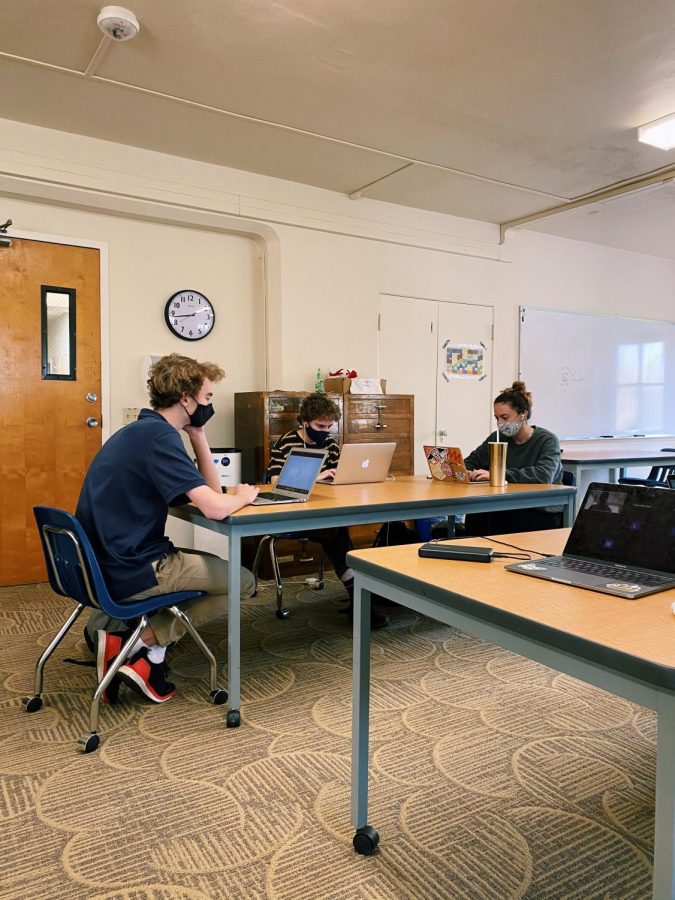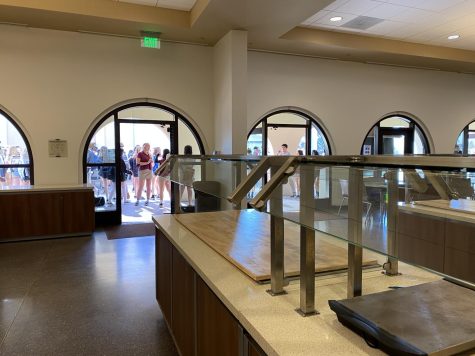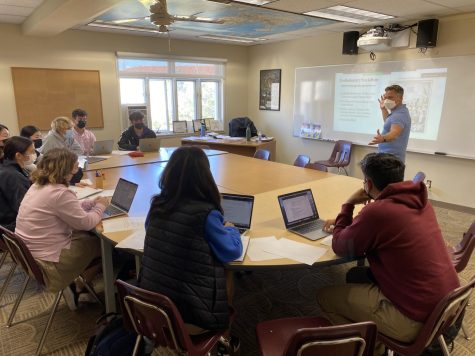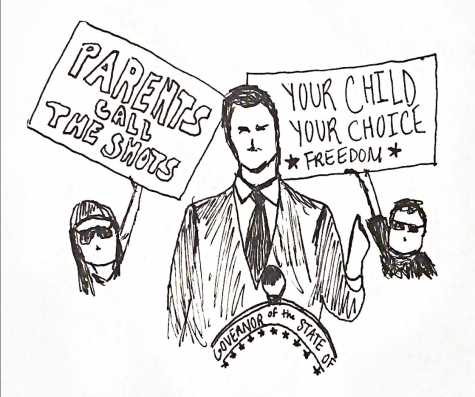Sweatpants or Social Distancing: The pros and cons of hybrid learning
Daniel White (‘21), Lucie Edwards (‘21), and Kyle Berlage (‘22) participate in The Tower through a hybrid format. Oftentimes, in-class discussions work the same, even if some students are on campus.
Students in disposable masks wince as feedback shrieks from the speaker of a helpless substitute teacher. At home, their classmates laugh awkwardly. The online teacher rolls their eyes as the substitute struggles to mute their computer. Another day of hybrid learning has begun.
During the COVID-19 pandemic, Bishop’s, like many other schools, transitioned to an all-virtual learning environment. As the months dragged on, schools throughout the nation, including Bishop’s, began employing hybrid learning techniques to minimize close contact and facilitate social distancing. At the beginning, nearly everyone took advantage of this opportunity and came to school, but as the weeks continued, more and more students began to stay home. While some of this can be attributed to rising COVID-19 cases in San Diego and numerous positive tests within the Bishop’s community, not everyone stays home because of health-related reasons. So, what are the drawbacks of hybrid learning that might be keeping students at home, and should the social and emotional benefits of on-campus learning outweigh the negatives?
The goal of hybrid learning rather than in-person is simple: limit COVID-19 contact. However, some articles noted that the half-baked nature of hybrid learning may attempt to simulate fully in-person learning, while raising new problems. One Vox article said that hybrid learning “might be the worst of both worlds.” One COVID-19 School Response Dashboard, an association of US schools, superintendents and principals, compiled data from schools across the country and found higher reported staff infection rates in a hybrid learning environment than a fully in-person one.
In The Washington Post, professor of epidemiology William Hanage explained that “hybrid plans can be among the most risky of all.” He went on to explain that the at-home days of a hybrid cycle can pose issues for working parents. They sometimes resort to childcare groups, where parents take turns supervising a group of children. “Hybrid school plans make it easier for the virus to transmit into schools,” he noted, “simply by producing more links between schools and families along which the virus can travel.”
Moreover, when teachers stay home, often because of health concerns, this can detract from the learning environment. “When I did go to school, the learning experience was very similar to an online experience,” explained Aidan Holden (’22). “A large portion of the other students… [were] on Zoom and… [sometimes] the teacher.” When teachers are online, students often encounter difficulties with the feedback that results from several microphones in one room. The academic experience is similar if the teacher is still teaching through the screen.
However, attending classes on Zoom can be isolating, so attending school, even if the teacher is not there, can significantly increase social interaction. “Even as a relatively shy person, I prefer interacting with people in-person because my connections with them feel more genuine than when I’m messaging or calling them over the internet,” Chris Jung (’22) explained. A Zoom class isolates each student, taking away the collaborative aspect of attending school. “I always come to school mainly because it gives me a chance to see my friends in person since hanging out over FaceTime is not as fun as hanging out in person,” noted Michelle Lai (’22).
If both teachers and students are in person, it’s usually a given that the students are getting a better education. An NBC News study entitled Kids Under Pressure found that 56% of students reported increased stress as a result of the pandemic and at-home learning, a large majority of them citing “grades, tests, and other assessments.” This was likely caused by a difficulty in communicating and retaining information online, leading to an academic disconnect.
At Bishop’s, science classes especially can benefit from in-person learning, since students can perform full labs rather than simply watching the teacher execute it. “The setup [on campus] was made to do these labs beforehand, and teachers don’t have to adapt to home [materials],” Serena Zhang (‘24) explained about her physics class. “A lot of things that are hands-on are much more difficult to emulate…at home.”
One of the leaders of the Kids Under Pressure study, Sarah Mills, emphasized the importance of in-person learning for teachers to be able to communicate ideas. “[Online,] it’s harder for teachers, for the adults in the school, to connect, and that’s a foundational element. In order for kids to learn, they need to feel safe and connected. Everything else rests on top of that.”
Additionally, even though many students get less sleep during in-person school because of travel time, attending on-campus classes can actually improve students’ energy. Brazilian researchers estimated a 35 percent reduction in physical activity and 28 percent rise in sedentary behavior during the pandemic. According to UCSF, daily step counts by smartphone users dropped up to 50% in the month following stay-at-home orders. So, not only does in-person learning help simulate a sense of normalcy, but being outside and walking from class to class helps improve physical and mental health.
Quarantine and Zoom have been shown to have negative effects on the brain. According to psychiatrist Gianpiero Petriglieri, “Our brain has to make an extra effort to compensate for all those aspects of communication we lack, and that’s tiring.” According to Psychiatric Times, audio and camera delays cause more disconnect and distrust between two people. The article, entitled A Neuropsychological Exploration of Zoom Fatigue, explained MRI data that revealed that communicating through a screen causes fatigue. “Live face-to-face interactions… are associated with greater activation in the same brain regions involved in reward,” the author, UCLA professor Dr. Jena Lee explained. This then stimulates alertness.
Amid floating rumors of the campus closing to low attendance grades, namely juniors and seniors, one can’t help but wonder if the social and emotional benefits of learning in person outweigh the practicality and increased COVID-19 transmission. The good news: with a vaccine in the coming year, students might be able to attend school with a much-decreased risk factor.

Clare Malhotra was born in Boston, Massachusetts and moved to La Jolla at age nine. She is currently a senior, and this is her third year on The Tower....











